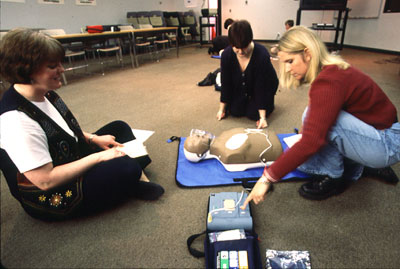
| Clinical Leadership | ||||||||
|
Seattle: "The Best Place in the Nation to Have a Heart Attack" |
||||||||
At the time, Cobb was director of cardiology at Harborview Medical Center in Seattle. The Belfast report made an impression on him. "I think it was the first time anyone had come forth with an organized effort to provide pre-hospital care for patients with cardiac disease," he said. The idea of assigning doctors and nurses to a mobile unit never caught on in the United States. Instead, a few physicians in five American cities developed an alternative program that created the paramedic. Seattle was one of those five cities, and Cobb was the local impetus behind the plan. The vision was to recruit firefighters to train as paramedics who would initiate pre-hospital emergency care for heart attack victims. Cobb and his colleagues obtained a grant to launch the effort through one of Lyndon Johnson's Great Society initiatives. By March of 1970, the first Medic One unit hit the streets of Seattle. A large motor home had been retrofitted as an emergency mobile unit. The first class of 15 firefighters trained as paramedics had learned to provide defibrillations, perform tracheal intubations, start an intravenous line, and administer medications to heart attack victims. For the first nine months, a physician accompanied the paramedics. When it became clear that paramedics could provide care on their own, the doctor stayed at the hospital and was in contact by radio or phone. During the first year, Medic One resuscitated and admitted 61 patients to the hospital. Of these, 31 were ultimately discharged. CBS's news program, 60 Minutes, featured Medic One and called Seattle "the best place in the nation to have a heart attack." When funding fell short in the early years, Cobb and his colleagues launched a grass roots effort that raised $200,000. Dr. Mickey Eisenberg, professor of medicine and medical program director for King County Emergency Medical Services, first met Cobb in 1971. At the time, Eisenberg was an intern and Cobb was his attending physician in the coronary care unit at Harborview Medical Center. According to Eisenberg, Cobb's contribution to emergency care for heart attack victims went well beyond launching Medic One in Seattle. "Leonard's approach was different in two areas. First, he envisioned a tiered-response system that enlisted the full strength of the Seattle Fire Department as first responders. By sending out Emergency Medical Technicians (EMTs) to administer CPR and oxygen, patients were kept alive until paramedics could arrive." Eisenberg continued, "Leonard also involved bystanders in part of the 'chain of survival' by setting up programs to teach citizens how to do CPR. This was very radical in 1971 when it was first proposed. Since then, Seattle has been the most CPR trained community in the world." Immediate CPR, followed by the quick arrival of advanced life support, was what made Seattle's at-the-scene heart attack treatment so successful. The model is now the national standard for emergency response to heart attacks. Eisenberg estimated that Seattle's Medic One and its related programs have saved more than 3,000 people. "These are lives that were quite literally snatched from the jaws of death," he said. |
||||||||
|
© 2003 - 2004 UW Medicine
Maintained by UW Health Sciences and Medical Affairs News and Community Relations Send questions and comments to drrpt@u.washington.edu |
||||||||


